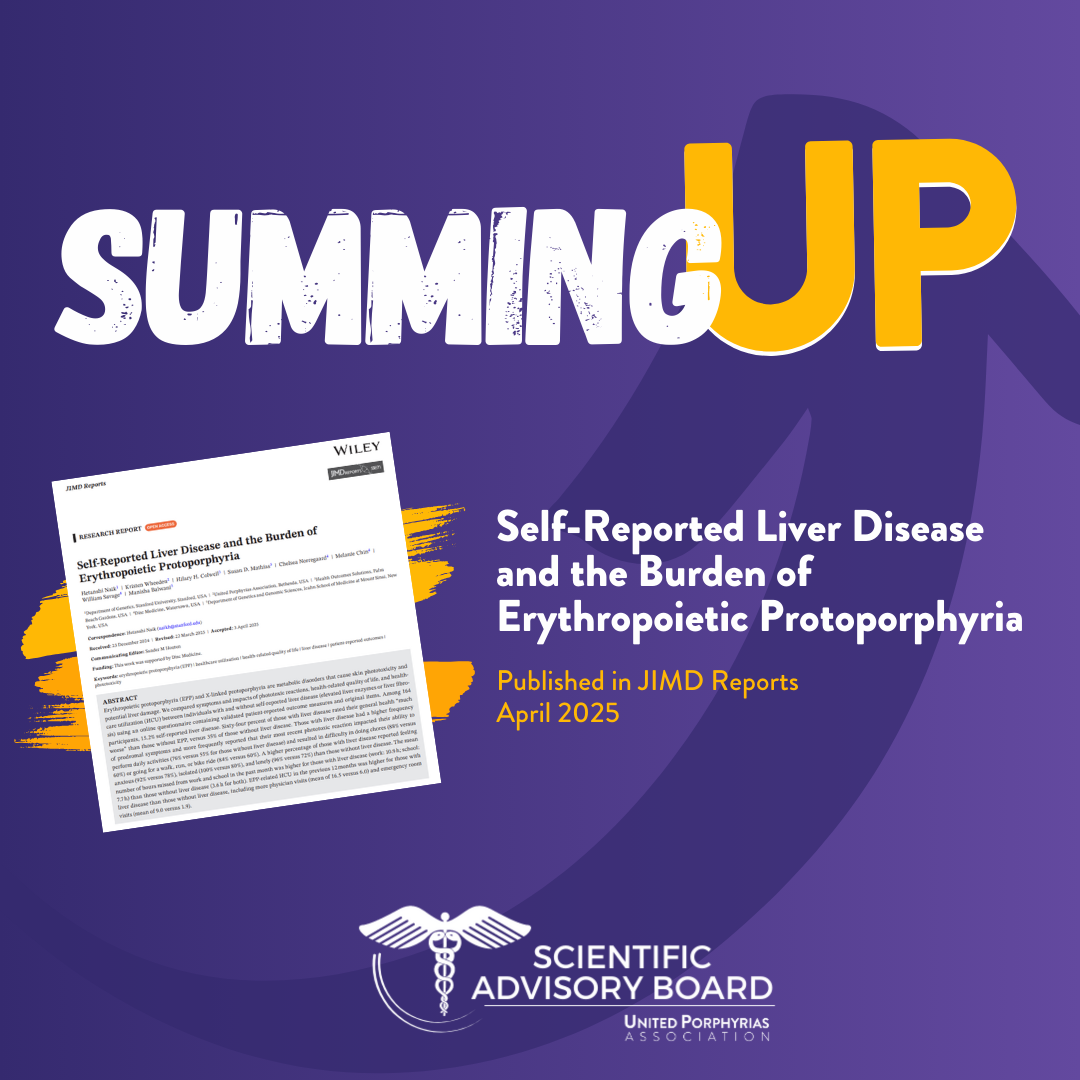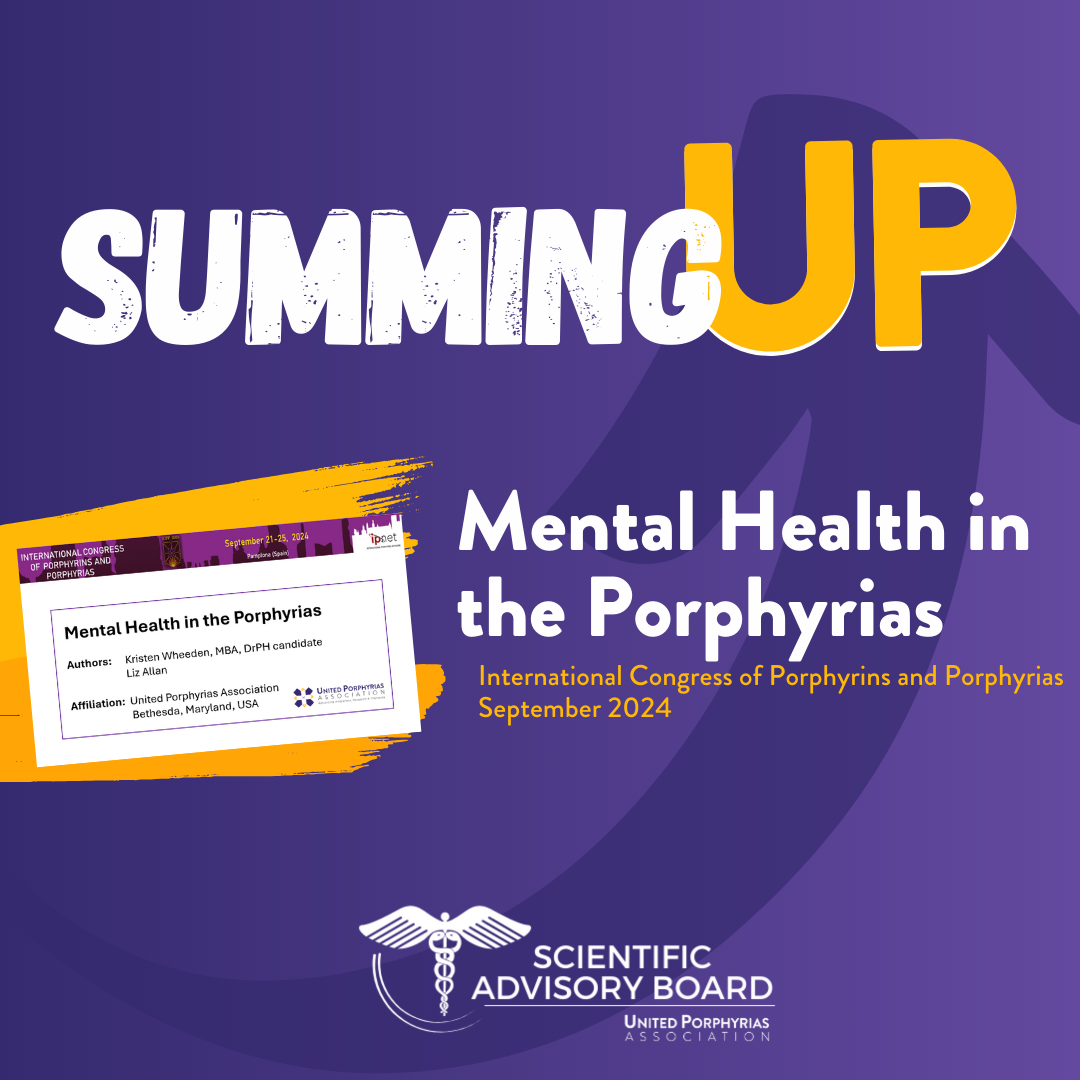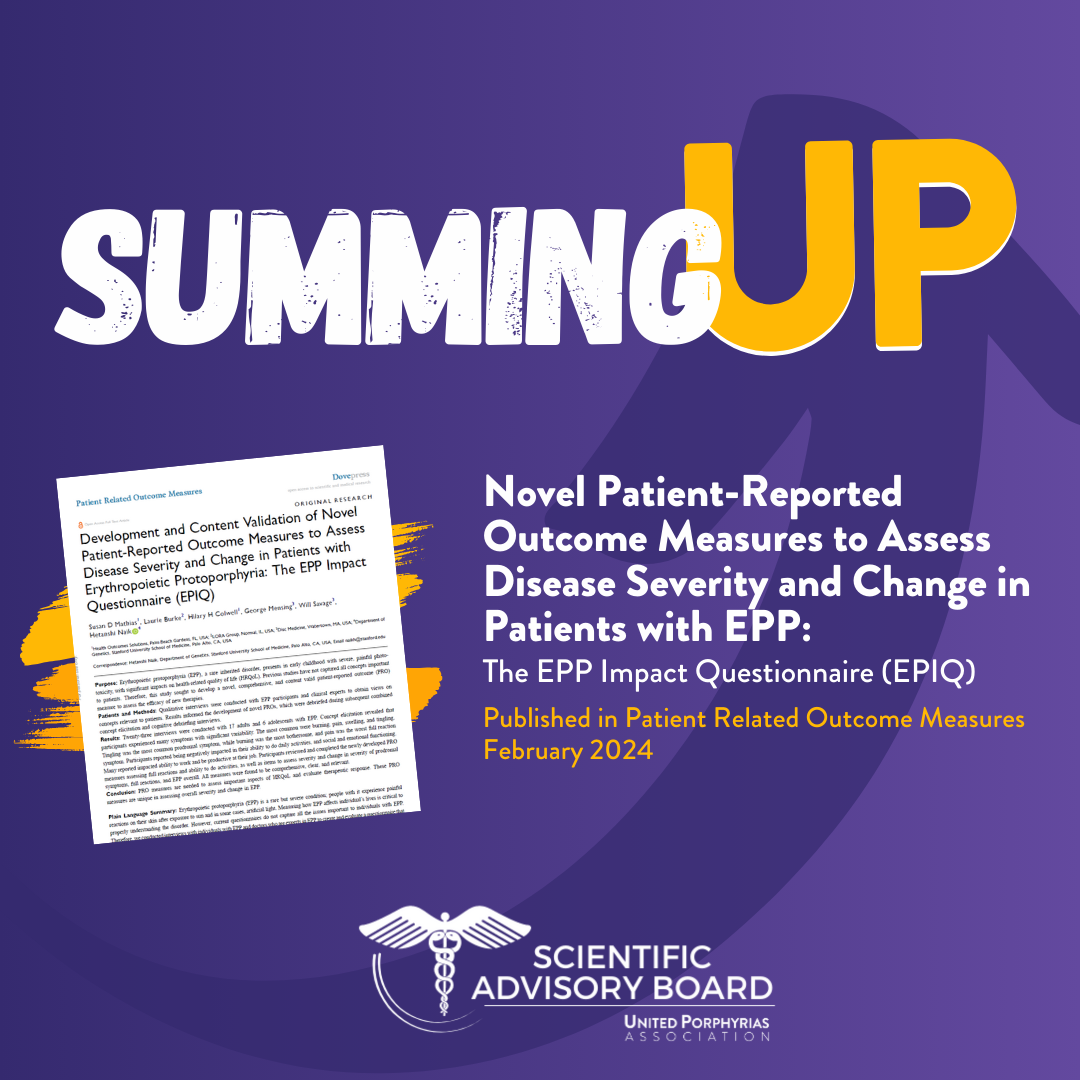EPP/XLP Consensus Guidelines
Summing UP features the latest porphyria research in easy-to-understand summaries that have been reviewed and approved by the UPA's Scientific Advisory Board of porphyria experts.
Summing UP: Evidence-based consensus guidelines for the diagnosis and management of erythropoietic protoporphyria and X-linked protoporphyria
Published Aug 2022
Journal of the American Academy of Dermatology
Full article here
This article provides guidelines for the diagnosis, treatment and management of erythropoietic protoporphyria (EPP) and X-linked protoporphyria (XLP).
How were these guidelines created?
These guidelines were created by porphyria experts from the Rare Diseases Clinical Research Network’s Porphyrias Consortium supported by the National Institute of Health. A literature review of research and case reports related to protoporphyrias was conducted. A group of 17 doctors across multiple specialties including dermatology, liver diseases, hematology and genetics with recognized expertise in porphyria, collaborated to establish the diagnostic and management guidelines. The clinicians reviewed the existing literature and evidence, evaluated the strength and quality of the evidence for diagnostic and management recommendations. When there was little or no evidence, recommendations were decided on by a consensus of the group.
Guidelines for the treatment of liver dysfunction in the protoporphyrias were created using the same process and are available here.
What are erythropoietic protoporphyria (EPP) and X-linked protoporphyria (XLP)?
EPP and XLP are rare genetic disorders that result in the accumulation of a molecule called protoporphyrin (PPIX) in the body. Protoporphyrin is made in red blood cells that are maturing in the bone marrow. Normally protoporphyrin will be turned into heme, which is part of the protein that allows mature red blood cells to transport oxygen in your blood. In EPP and XLP, the protoporphyrin doesn’t all get used and accumulates in the body, mostly in your red blood cells, plasma and liver.
The primary symptoms of both EPP and XLP is sensitivity to visible light (photosensitivity), specifically blue light. When light passes through the outer layers of your skin, it activates the protoporphyrin. The activated protoporphyrin reacts with the surrounding skin tissue and begins by causing sensations like tingling, itching and burning that will progress to severe pain, sometimes accompanied by redness and swelling, with continued light exposure. This pain is not responsive to pain medication and may take several days to resolve. People with protoporphyria learn to avoid sunlight and quality of life can be significantly affected.
Symptoms generally appear in childhood, however the average time to diagnosis is over 10 years and evidence suggests that it is still underdiagnosed.
How are protoporphyrias diagnosed?
Biochemical testing
A blood test for total erythrocyte protoporphyrin that includes proportions of metal-free and zinc-bound protoporphyrin is the recommended test for diagnosing EPP and XLP. Protoporphyria is diagnosed when this test shows significant elevations (at least 3x above the normal upper limit) of mostly (more than 50%) metal-free protoporphyrin. Lower levels of protoporphyrin or mostly zinc-bound protoporphyrin can be a sign of other conditions such as lead intoxication or anemia.
It is important that testing be done properly. There are some important things to be aware of:
Labs have different methods of measuring protoporphyrin, and some methods can lead to a false negative result. Consult the UPA’s list or contact your country’s porphyria organization to find an appropriate lab.
Exposure to light can cause inaccurate test results. Your sample should be wrapped in foil after collection.
Urine and fecal porphyrins are usually normal in EPP and XLP, these tests are not recommended. Skin biopsies do not diagnose EPP and are not recommended unless ruling out other conditions.
Plasma porphyrin levels are not always increased; therefore, it should not be used for first line testing.
Genetic testing
Genetic testing without a biochemical test confirming elevated protoporphyrin is not recommended because 1) for a small proportion of patients (~4%), a genetic cause isn't identifiable, and 2) sometimes it is unclear if a genetic mutation would cause porphyria (“variant of uncertain significance”).
Once a biochemical diagnosis has been made, genetic testing should be conducted to distinguish between EPP and XLP:
EPP is caused by changes in both copies of the FECH gene. Often, one of the two copies will be a common, lower functioning variant of the FECH gene. This common variant does not cause porphyria on its own (even if you have two copies), it needs to be paired with a rarer pathogenic variant of FECH.
XLP is caused by a change to the ALAS2 gene. This gene is found on the X chromosome. Because males only have one X chromosome, they only have one copy of the ALAS2 gene and will therefore have XLP symptoms. Because females have two X chromosomes, the severity of their XLP can vary from mild to severe.
Genetic counseling before having children is recommended for couples with a personal or family history of protoporphyria.
Managing protoporphyria with medication and supplements
Recommended treatments
Currently there are no approved pharmacological treatments for children with protoporphyrias.
Afamelanotide (Scenesse) is recommended for treatment of protoporphyria in adults. It has been shown to increase the time in the sun that is pain-free and improve quality of life by increasing the production of melanin, which makes your skin darker/tanned and provides sun protection. The increase in melanin may also help neutralize a protoporphyria reaction. If you are on afamelanotide, it is recommended that you have a full-body skin examination by a dermatologist every 6 months.
Note: there is no data on the safety of afamelanotide for pregnant women. It therefore cannot be recommended for use during pregnancy.
Dersimelagon (MT-7117) is another treatment which shows promise and it currently in phase 3 trials.
Not recommended
There are several other therapies which has been used to treat protoporphyrias. Because there is a lack of data and/or evidence related to their usefulness, the following therapies are NOT recommended:
Beta-carotene, cysteine, cimetidine, isoniazid, warfarin, quinacrine, oral zinc, N-acetylcysteine, vitamin C, omega-3 fatty acids, oral adenosine monophosphate, canthaxanthine, terfenadine, inosine, dithiothreitol and glycerol, pyridoxine, and hydroxyethylrutosides.
Preventing and managing phototoxic reactions
The existing literature doesn’t have a lot of published data on the best ways to manage protoporphyrias. Common practices were evaluated to compare potential benefits and risks:
Recommended (potential benefit outweighs the risks but little or no published data)
Sunlight avoidance
Using opaque clothing
Broad-spectrum or tinted (zinc oxide or titanium dioxide) sunscreens, other types of sunscreens are not useful
Window tinting for cars
Possible benefit
Some patients report cold compresses and cooling devices provide minor relief of phototoxic symptoms, others report that both cold and heat worsen symptoms.
Use indoor lights with minimal blue light if you are sensitive to indoor lights
Not helpful/not recommended
Painkillers, including narcotics, acetaminophen (ex. Tylenol) and NSAIDs (ex. ibuprofen or aspirin)
Anti-inflammatory medications like corticosteroids
Antihistamines
Living with porphyria
The guidelines recommend:
Accessing patient groups (social media groups, summer camps for families, patient meetings, etc.) to share advice and experiences
Depending on symptom severity, seeking out accommodations at work or school, and educating teachers to better understand children’s needs
Educating children to explain their disease and advocate for their own light avoidance
Monitoring and managing potential complications
Anemia
Mild anemia, where your body has difficulty transporting enough oxygen, is common in protoporphyria and should tested for annually.
In EPP, iron supplementation may make photosensitivity worse, and should be considered only if the patient has anemia symptoms or very low iron stores.
In XLP, iron supplementation is recommended if iron is low. In XLP, iron supplementation may reduce protoporphyrin levels and photosensitivity.
Liver disease
A small number of protoporphyria patients develop liver disease and liver failure. Liver tests should be done at least annually for monitor function. Detailed information about monitoring, managing and treating protoporphyria-related liver disease is available from the consensus guidelines for treating protoporphyria-related liver disease.
Vitamin D deficiency
Because of lifelong sunlight avoidance, vitamin D levels should be tested for at least annually. Vitamin D deficiency should be treated normally, according to the guidelines in your area.
Anxiety and depression
Anxiety and depression due to protoporphyria-related symptoms in adults does not appear to be higher than the rates of anxiety and depression general population, and the impact of porphyria on children has not been well studied. Patients should receive the same screening for anxiety/depression as the general population.
Surgery
For short surgeries and endoscopies, no light modification is needed. For prolonged surgeries, light acrylate yellow filters for wavelengths 340-470nm are recommended.
There are no anesthetic or other medications used during surgery that are contraindicated (unsafe) for protoporphyria.
Light and laser therapies
Lights that are outside of the 340-650nm light range are considered safe, but a spot test is recommended before beginning treatment.
Pregnancy
Pregnant porphyria patients should receive the same medical and prenatal care as the general population. There is no need for increased monitoring during or after pregnancy.
There have been some reports that protoporphyria symptoms improve during pregnancy, but these reports are inconsistent.
Conclusion
EPP and XLP affect multiple systems in the body and present with severe phototoxic reactions that lead to sun avoidance, decreased quality of life and, in rare cases, liver failure.
These guidelines will help to standardize care and make it easier to identify patients at risk for long-term complications.
CONTENT REVIEWED BY UNITED PORPHYRIAS ASSOCIATION SCIENTIFIC ADVISORY BOARD






